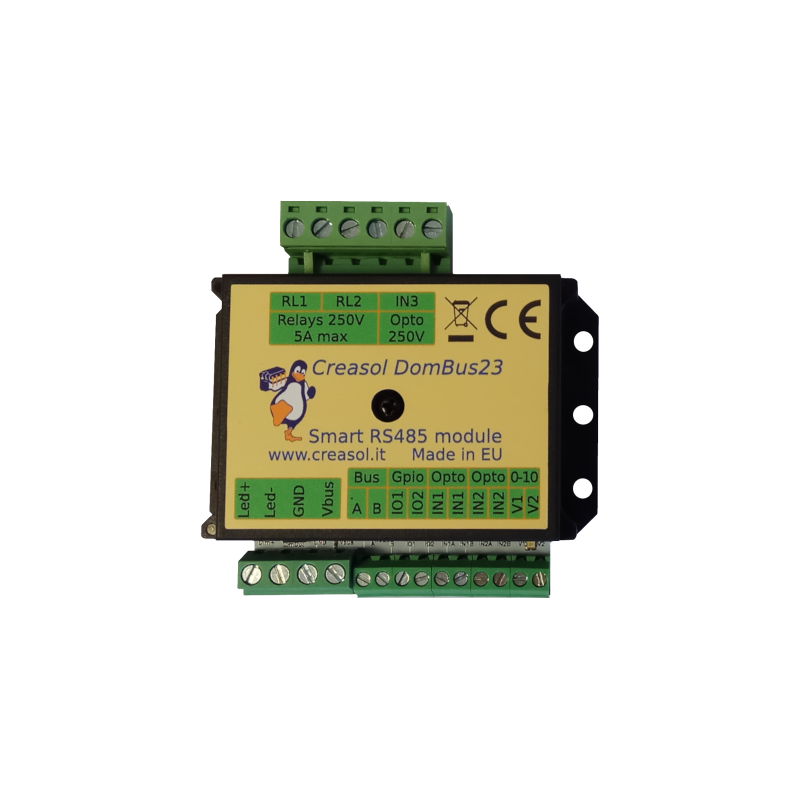

Email: store@creasol.it - Telegram: CreasolTech - Whatsapp: +393283730010
Prioritná pošta: rýchlo a lacno - Expresný kuriér: r
Pred vrátením produktov nás kontaktujte!

Creasol DomBus23 je modulpre domáci automatizačný systéms niekoľkými rôznymi druhmi vstupov / výstupovv krátkej veľkosti: 74x72x24mm. p>
Môže byť pripojený k radiču Domoticz pomocou sériovej zbernice RS485 (4 vodiče, 2 pre napájanie 12 / 24V a 2 pre dáta rýchlosťou 115200 bps).
Rovnako ako iné zariadenia DomBus,DomBus23 je navrhnutý tak, aby spotreboval nízku energiu, bol spoľahlivý, plne konfigurovateľný a ľahko použiteľný.
 Plná podpora: väčšina produktov je navrhnutá nami!
Plná podpora: väčšina produktov je navrhnutá nami!
Email: store@creasol.it - Telegram: CreasolTech - Whatsapp: +393283730010
 Objednávky sú odoslané do 1 pracovného dňa
Objednávky sú odoslané do 1 pracovného dňa
Prioritná pošta: rýchlo a lacno - Expresný kuriér: r
 Záruka 24 mesiacov, jednoduché vrátenie/vrátenie peňazí
Záruka 24 mesiacov, jednoduché vrátenie/vrátenie peňazí
Pred vrátením produktov nás kontaktujte!
Creasol DomBus23 je modulpre domáci automatizačný systéms niekoľkými rôznymi druhmi vstupov / výstupovv krátkej veľkosti: 74x72x24mm. p>
Môže byť pripojený k radiču domácej automatizácie pomocou sériovej zbernice RS485 (4 vodiče, 2 pre napájanie 12 / 24V a 2 pre dáta rýchlosťou 115200 bps).
Podporované ovládače systému domácej automatizácie súDomoticz.
Rovnako ako iné zariadenia DomBus,DomBus23 je navrhnutý tak, aby spotreboval nízku energiu, bol spoľahlivý, plne konfigurovateľný a ľahko použiteľný.
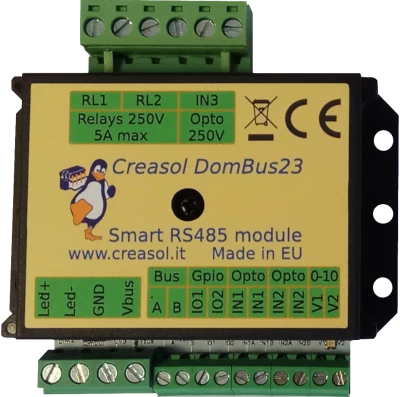
p>
silný>
Viac informácií na https://www.creasol.it/CreasolDomBus23
Predvolená adresa: 0xff23
| Port # | názov | Schopnosti | Predvolená konfigurácia | Popis |
| 1 | RL1 | OUT_DIGITAL, OUT_RELAY_LP, OUT_BLIND | OUT_RELAY_LP | Reléový výstup SPST s kontaktnou rýchlosťou 250 V str. 5 A alebo kontaktnou rýchlosťou 30 V ss. Reléový kontakt je chránený pred prepätím varistorom |
| 2 | RL2 | OUT_DIGITAL, OUT_RELAY_LP, OUT_BLIND | OUT_RELAY_LP | Reléový výstup SPST s kontaktnou rýchlosťou 250 V str. 5 A alebo kontaktnou rýchlosťou 30 V ss. Reléový kontakt je chránený pred prepätím varistorom |
| 3 | MOS | OUT_DIGITAL, OUT_DIMMER | OUT_DIMMER | Výstup s otvoreným odtokom Mosfet, max. 30 V, 12 A, vhodný na riadenie LED pásikov (s možnosťou regulácie jasu pomocou funkcie stmievania DomBus, 0-100% s krokom 5%) alebo iných jednosmerných záťaží. |
| 4 | V1 / OD1 | OUT_ANALOG, OUT_DIGITAL, OUT_RELAY_LP, OUT_BLIND | OUT_ANALOG |
Analógový výstup, 0-10V, vhodný na riadenie vstupu 0-10V alebo 1-10V na inej elektronickej doske (stmievač, tepelné čerpadlo, lineárny ventil, ...). |
| 5 | V2 / OD2 | OUT_ANALOG, OUT_DIGITAL, OUT_RELAY_LP, OUT_BLIND(1) | OUT_ANALOG | OAnalogový výstup, 0-10V, vhodný na riadenie vstupu 0-10V alebo 1-10V na inej elektronickej doske (stmievač, tepelné čerpadlo, lineárny ventil, ...). Voliteľne je možné tento port nakonfigurovať ako výstup s otvoreným odtokom max. 40 V, 100 mA, ktorý je možné pripojiť k externým LED diódam alebo relé pomocou voliteľného 5-žilového kábla:od2Spojka s plošnými spojmi musí byť v tomto prípade skratovaná. |
| 6 | IO1 | IN_DIGITAL,IN_ANALOG, IN_TWINBUTTON, IN_COUNTER, OUT_DIGITAL, OUT_BLIND, OUT_DIMMER, OUT_BUZZER | IN_DIGITAL |
Analógový / digitálny vstup, ktorý je možné použiť na čítanie napätia alebo ktorý je možné pripojiť ku kontaktu, spínaču, magnetickému snímaču, PIR, ... |
| 7 | IO2 | IN_DIGITAL, IN_ANALOG, IN_TWINBUTTON, IN_COUNTER, OUT_DIGITAL, OUT_BLIND(1), OUT_DIMMER, OUT_BUZZER | IN_DIGITAL | Analógový / digitálny vstup, ktorý je možné použiť na čítanie napätia alebo ktorý je možné pripojiť ku kontaktu, spínaču, magnetickému snímaču, PIR, ... Môže byť nakonfigurovaný ako počítadlo a pripojený k meraču energie / plynu / vody. Môže byť nakonfigurovaný ako IN_TWINBUTTON (ktorý je možné pripojiť k dvojitému tlačidlu) skratom jumperu PCBRU2alebo 10mA VÝSTUP skratom prepojky na DPSRO2: v druhom prípade môže byť použitý ako nízkonapäťový 3V výstup, pripojený k bzučiaku alebo k doske relé v budiči cievky. |
| 8 | IN1 | IN_AC | IN_AC, IN_COUNTER | Nízkonapäťový vstup, 9-40 V str. Alebo DC, opticky izolované. Vhodné na vycítenie prítomnostiNapätie |
| 9 | IN2 | IN_AC | IN_AC, IN_COUNTER | Nízkonapäťový vstup, 9-40 V str. Alebo DC, opticky izolované. Vhodné na snímanie prítomnosti napätia |
| 10 | IN3 | IN_AC | IN_AC, IN_COUNTER | Vstup 230V, opticky izolovaný. Vhodné na snímanie prítomnosti napätia a zisťovanie výpadku napájania (výpadok napájania) |
(1): možno použiť ako slepý výstup na otvorenie žalúzie / clony, ale iba predchádzajúci port je možné nakonfigurovať v Domoticz ako OUT_BLIND, pretože keď je nakonfigurovaný ako OUT_BLIND, zariadenie DomBus automaticky nakonfiguruje nasledujúci port na riadenie relé v otvorenom stave smer.
Modul DomBus23 môže byť prepojený s Domoticz a pomocou interného mosfetu s 30V 12A môže interne regulovať jas LED pásky.
DomBus23 má tiež 2 analógové výstupy 0-10 V, ktoré umožňujú riadenie ďalších 2 LED pásikov externým LED stmievačom.

Nasledujúca schéma ukazuje, ako pripojiť otvárač brány alebo otvárač garážových brán k modulu DomBus23, ktorý umožňuje ovládanie brány a garážových brán pomocou domáceho automatizačného systému (Domoticz, ...)
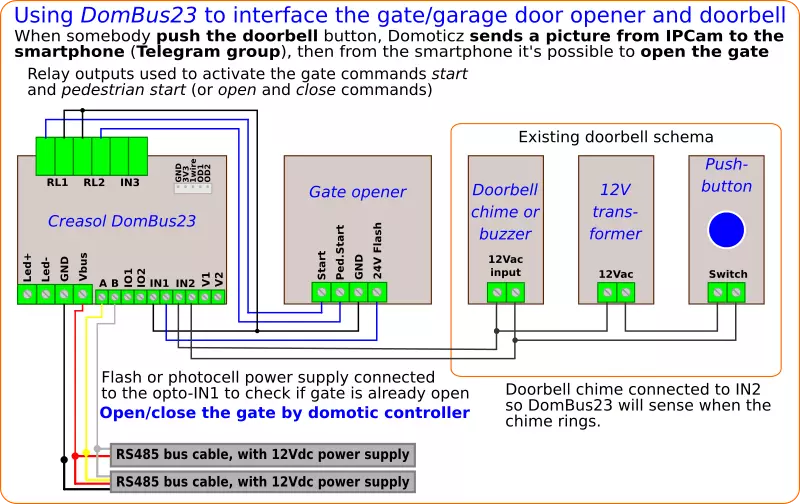
Viac informácií na https://www.creasol.it/CreasolDomBus23
The following video shows a presentation of some domotic modules designed and produced in Italy by Creasol to make a reliable, easy and power-optimized home automation system.
The next video shows our Smart EVSE module that can be used to charge the electric car by using only solar power, or adding 25/50/75/100% of available power from the electrical grid.
Our industrial and home automation modules are designed to be
Modules are available in two version:
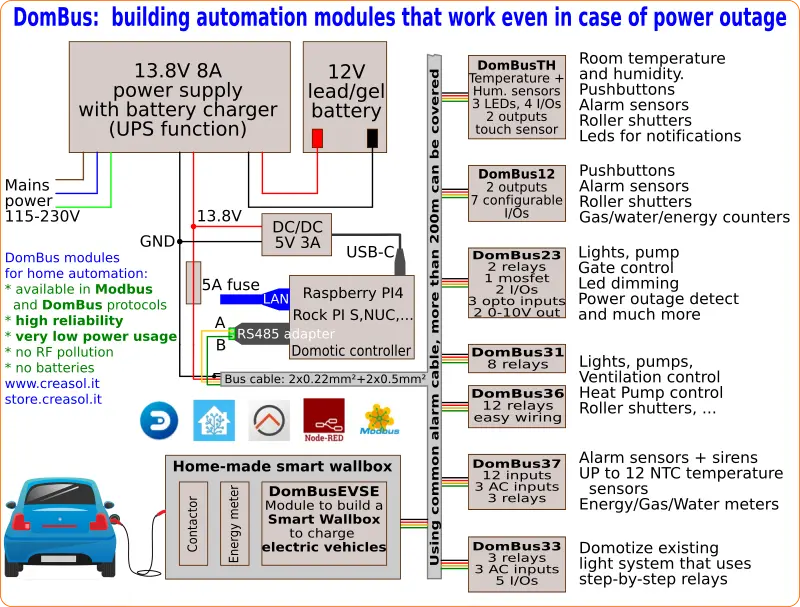
Store website - Information website
For our products we can offer FULL SUPPORT and CUSTOMIZATION: please contact us by Email or Telegram
 Complete solution to make a Smart EVSE, charging the electric vehicle using only energy from renewable source (photovoltaic, wind, ...), or adding 25-50-75-100% of available power from the grid.
Complete solution to make a Smart EVSE, charging the electric vehicle using only energy from renewable source (photovoltaic, wind, ...), or adding 25-50-75-100% of available power from the grid.
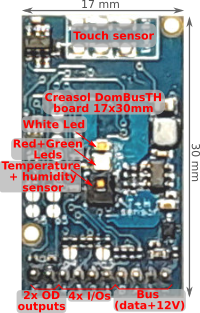 Compact board, 32x17mm, to be installed on blank cover with a 4mm hole in the middle, to exchange air for the relative humidity sensor. It can be installed in every room to monitor temperature and humidity, check alarm sensors, control blind motor UP/DOWN, send notifications (using red and green leds) and activate white led in case of power outage.
Compact board, 32x17mm, to be installed on blank cover with a 4mm hole in the middle, to exchange air for the relative humidity sensor. It can be installed in every room to monitor temperature and humidity, check alarm sensors, control blind motor UP/DOWN, send notifications (using red and green leds) and activate white led in case of power outage.
Includes:
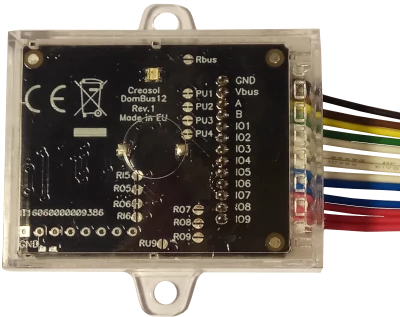 Very compact, versatile and cost-effective module with 9 ports. Each port can be configured by software as:
Very compact, versatile and cost-effective module with 9 ports. Each port can be configured by software as:
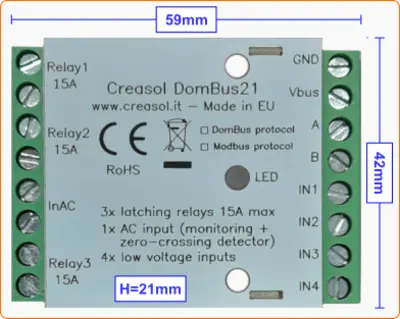 Very low power consumption module designed to enable up to 3 high power loads, up to 15A (3kW).
Very low power consumption module designed to enable up to 3 high power loads, up to 15A (3kW).
 Versatile module designed to control gate or garage door.
Versatile module designed to control gate or garage door.
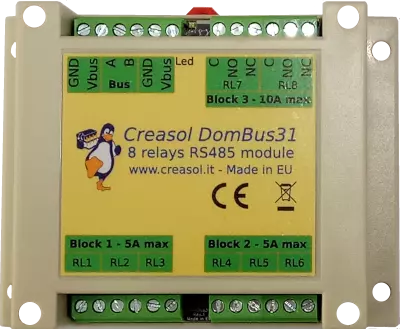 DIN rail low profile module, with 8 relays and very low power consumption:
DIN rail low profile module, with 8 relays and very low power consumption:
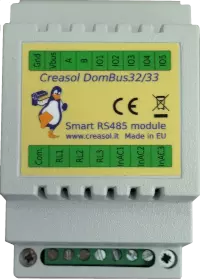 Versatile module with 230V inputs and outputs, and 5 low voltage I/Os.
Versatile module with 230V inputs and outputs, and 5 low voltage I/Os.
 Module designed to control 3 lights already existing and actually controlled by 230V pushbuttons and step-by-step relays. In this way each light can be activated by existing pushbuttons, and by the domotic controller.
Module designed to control 3 lights already existing and actually controlled by 230V pushbuttons and step-by-step relays. In this way each light can be activated by existing pushbuttons, and by the domotic controller.
Each relay can toggle the existing step-relay, switching the light On/Off. The optoisolator monitors the light status. The 5 I/Os can be connected to pushbuttons to activate or deactivate one or all lights.
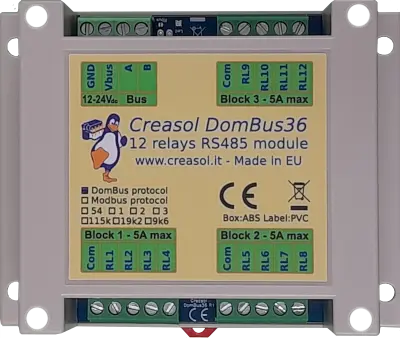 DIN rail module, low profile, with 12 relays outputs and very low power consumption.
DIN rail module, low profile, with 12 relays outputs and very low power consumption.
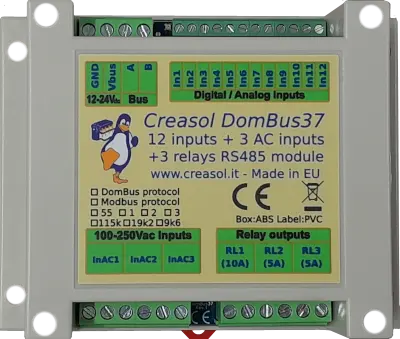 Module designed to be connected to alarm sensors (magnetc contact sensors, PIRs, tampers): it's able to monitor mains power supply (power outage / blackout) and also have 3 relays outputs.
Module designed to be connected to alarm sensors (magnetc contact sensors, PIRs, tampers): it's able to monitor mains power supply (power outage / blackout) and also have 3 relays outputs.
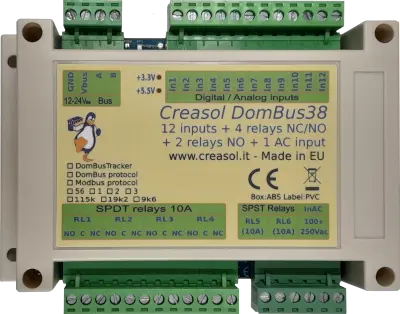 DIN rail module designed for burglar alarm system.
DIN rail module designed for burglar alarm system.
![]() DIN rail module that control azimuth + elevation/tilt motors of a sun tracker, to maximize photovoltaic energy production during the day and seasons.
DIN rail module that control azimuth + elevation/tilt motors of a sun tracker, to maximize photovoltaic energy production during the day and seasons.
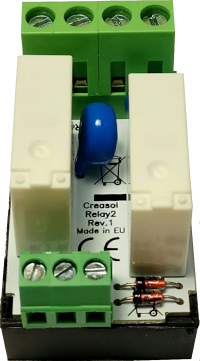 Simple module with 2 relays, to be used with DomBus modules or other electronic boards with open-collector or open-drain outputs
Simple module with 2 relays, to be used with DomBus modules or other electronic boards with open-collector or open-drain outputs
 IoT board designed for NodeMCU v3 board using ESP8266 WiFi microcontroller
IoT board designed for NodeMCU v3 board using ESP8266 WiFi microcontroller
I'm using it to dimmer a LED strip with domoticz.
Just connect the power supply and led strip, and it works without expensive external dimmers.